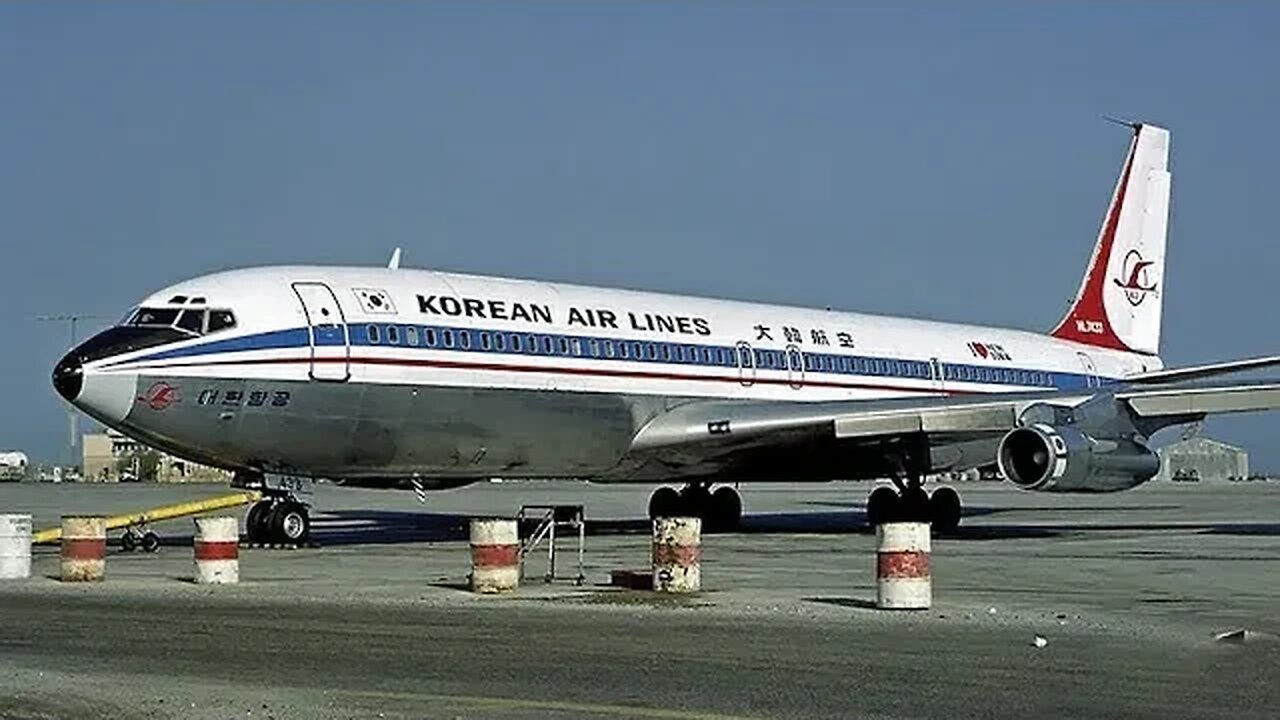Premium Only Content

Korean Air Lines Flight 902,Voo Korean Air Lines 902
On April 20, 1978, over the Karelia region, a Soviet Su-15 fighter piloted by Captain Alexander Bosov intercepted and hit a Boeing 707-321B plane (registration number HL7429) belonging to the South Korean airline Korean Air Lines ( flight KAL902), piloted by Captain Kim Chang Kyu. There were 12 crew and 97 passengers on board.
The plane was following the route Paris - Anchorage - Seoul. Due to failures in the navigation equipment, the Boeing deviated from the route and ended up flying over the Kola Peninsula, violating the USSR's air border. When approaching the North Magnetic Pole, the navigation system and compass fail (according to another version, the crew made a mistake in calculating the magnetic declination), as a result of which the autopilot directed the plane to the southeast. The crew did not notice and continued the flight.
At 20:54, KAL 902 was spotted by Soviet air defense radars about 400 km from USSR territorial waters. At 9:19 pm, the Boeing flew into Soviet airspace and the alarm was raised and a Su-15 fighter was sent to intercept the intruder.
The Su-15, piloted by Alexander Bosov, intercepted the 707 and identified it as a civil aircraft. Neither the Korean crew nor the Soviet fighter were able to establish radio contact. Captain Bosov gave a landing signal in the air: “shaking his wings” and “flapping his nose”. However, the crew began to turn towards Finland.The leadership of the USSR Air Defense Command then gave the order to shoot down the plane. At 9.42pm, the Su-15 launched an air-to-air missile at the aircraft: an R-8 missile damaged the 707, forcing the crew to make an emergency landing on frozen Lake Korpijärvi near the Finnish border.
The accident cost the lives of 2 passengers who were fatally injured by splinters that pierced the fuselage. Five years later the KAL 007 tragedy occurred, again with a Sukhoi Su-15, but this is obviously another story.
Há 45 anos começou a infame fama internacional do interceptador Sukhoi Su-15, infelizmente conhecido como Boeing Killer.
Em 20 de abril de 1978, sobre a região da Carélia, um caça soviético Su-15 pilotado pelo capitão Alexander Bosov interceptou e atingiu um avião Boeing 707-321B (número de registro HL7429) pertencente à companhia aérea sul-coreana Korean Air Lines (voo KAL902), pilotado pelo Capitão Kim Chang Kyu. Havia 12 tripulantes e 97 passageiros a bordo.
O avião seguia a rota Paris - Anchorage - Seul. Devido a falhas no equipamento de navegação, o Boeing desviou-se da rota e acabou sobrevoando a Península de Kola, violando a fronteira aérea da URSS. Ao se aproximar do Pólo Norte Magnético, o sistema de navegação e a bússola falham (segundo outra versão a tripulação cometeu um erro no cálculo da declinação magnética), pelo que o piloto automático direcionou o avião para sudeste. A tripulação não percebeu e continuou o vôo.
Às 20h54, o KAL 902 foi avistado por radares de defesa aérea soviéticos a cerca de 400 km das águas territoriais da URSS. Às 21h19, o Boeing voou para o espaço aéreo soviético e o alarme foi disparado e um caça Su-15 foi enviado para interceptar o intruso.
O Su-15, pilotado por Alexander Bosov, interceptou o 707 e identificou-o como aeronave civil. Nem a tripulação coreana nem o caça soviético conseguiram estabelecer contato por rádio. O capitão Bosov deu um sinal de pouso no ar: “balançando as asas” e “batendo o nariz”. No entanto, a tripulação começou a virar-se para a Finlândia.A liderança do Comando de Defesa Aérea da URSS deu então a ordem para abater o avião. Às 21h42, o Su-15 lançou um míssil ar-ar contra a aeronave: um míssil R-8 danificou o 707, forçando a tripulação a fazer um pouso de emergência no congelado Lago Korpijärvi, perto da fronteira finlandesa.
O acidente custou a vida de 2 passageiros que foram mortalmente feridos por estilhaços que perfuraram a fuselagem. Cinco anos depois ocorreu a tragédia do KAL 007, novamente com um Sukhoi Su-15, mas esta é obviamente outra história.
-
 1:53:32
1:53:32
Glenn Greenwald
4 hours agoWhy Did Zohran Win in NYC? Plus: Gazan Pulitzer Prize Winner Mosab Abu Toha on the Latest Atrocities | SYSTEM UPDATE SHOW #476
168K55 -
 1:41:14
1:41:14
RiftTV/Slightly Offensive
7 hours agoCrowder Takes SHOT at Candace, “Panicans” OBLITERATED? | The Rift | Guests: Hodge Twins
34.1K9 -
 LIVE
LIVE
Spartan
3 hours agoPro Halo Player | Sens Crisis Grind | Ranked Arena, Probably SWTOR at some point
94 watching -
 2:22:56
2:22:56
EnDuEnDo
3 hours ago🚨Variety Stream 🎮 Push to 600 Followers 🚀 Chill Vibes 😎 Content Creator for @SelfMadeGGs & @SMKAcademy
5.56K -
 1:24:04
1:24:04
Playback Request Live
4 hours agoMillennial Meltdown: 2000s Pop Hits & Tabloid Twists
4.76K1 -
 LIVE
LIVE
Melonie Mac
3 hours agoGo Boom Live Ep 52!
169 watching -
 1:04:22
1:04:22
BonginoReport
4 hours agoNYC Chooses Socialist Mayoral Candidate - Nightly Scroll w/ Hayley Caronia (Ep.77) - 06/25/2025
141K72 -
 1:15:24
1:15:24
Kim Iversen
5 hours agoMamdani Wins: Red Scare, or Red, White and Blue Wake-Up Call?
67.8K67 -
 4:49:46
4:49:46
Akademiks
5 hours agoDiddy Trial Day 30: Prosecutor Drops Bombshell. REMOVES Several Charges from Diddy before JURY. 2/30
52.7K5 -
 1:31:08
1:31:08
The Mike Schwartz Show
4 hours agoTHE MIKE SCHWARTZ SHOW Evening Edition 06-25-2025
22.6K4